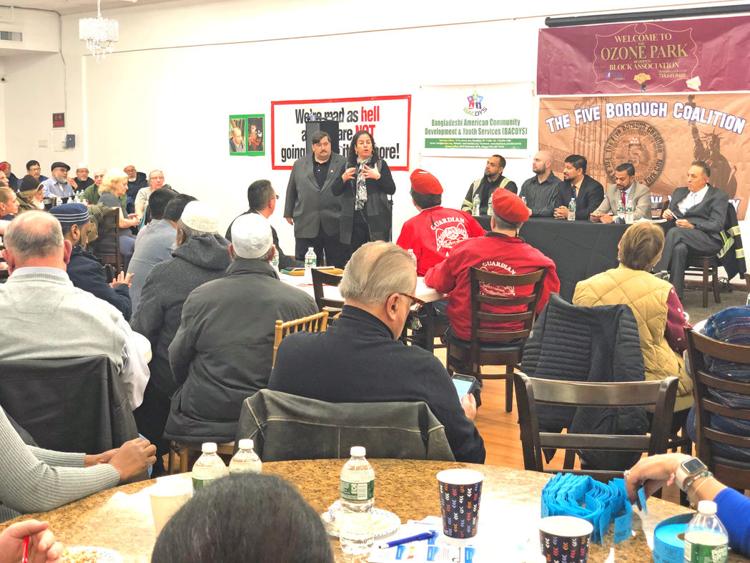City Limits
Florina, 62, and her husband, who is 63, haven’t paid rent on their rent-regulated Bronx apartment in months.
The husband has not been able to work in 16 years and is blind. Florina does sporadic cleaning work to bring in extra income but is otherwise retired. Neither receives any kind of disability or Social Security benefit, due to their immigration status.
In January of 2019, Florina received a notice saying that her rent would go up by 30 percent, an amount the family couldn’t pay.
The couple are one of a few dozen residents of a building in the Bronx who are now on a rent strike.
The couple, along with their children and grandchildren, with whom they live, are protesting a Major Capital Improvement – a rent hike on regulated units intended to fund building-wide repairs that they said raises their rent beyond what they can pay. The hike was approved prior to last summer’s rent reforms, which curtailed the practice. They are also protesting deteriorating conditions in their home.
In response, their landlord took the couple to court in an attempt to evict the family. Their hearing has been postponed until March, thanks to the intervention of a lawyer. But Florina and her husband still fear they will be evicted, along with their working age children and young grandchild.
Florina is fortunate, she says, that she lives with children – her son, 39, works at a bakery and her daughter, 30, is a home-health aide. While their combined income does not pay for the increased rent on their apartment, being partially supported by a younger generation is not something all elder New Yorkers have.
Many elder New Yorkers without such family ties and with little retirement savings end up displaced, segregated to an adult home, or worse, shuffled into the city’s homeless shelter system when they become ill.
“Sadly a lot of older, disabled people believe ‘they can’t throw me out into the street’,” says Justin La Mort, a housing lawyer with the group Mobilization for Justice who works with elders. “The bad news is, in fact, they can. It’s just a matter of time.”
The city uses a patchwork of social services and subsidies to keep elders aging in place, but they can be difficult to qualify for and their funds are limited. For those without savings or income from work, federal programs—SSI, SSDI or social security—can come too late and, when they do arrive, may not meet the high cost of rent in New York City. The result is a permanent sense of precarity among the city’s most vulnerable, sometimes culminating in homelessness or displacement.
A lack of retirement savings compounds the problem. According to the commissioner of the city’s Department of Consumer Affairs, half of New Yorkers 55 and older have no money in traditional retirement accounts. 40 percent of New Yorkers between 50 and 64 have less than $10,000 saved in such accounts. Nationally, 29 percent of adults above 55 have neither a pension nor retirement savings, according to the Government Accountability Office.
This lack of assets can have material effects when older adults face hardships: a recent study from the non-profit Robin Hood looked at material hardship, spurred by housing insecurity, job loss or illness. The study found that 53 percent of New Yorkers experienced such hardship for at least one year in the survey’s four year timespan.
According to the same report, 23 percent of respondents experienced poor health between 2012-2018. The study also found housing subsidies and rent regulations had reduced the poverty rate by 5 percent.
Elders who become disabled suddenly can find themselves in a grey area where social services can’t help them. Awaiting disability benefits, for which they may be rejected, they could find themselves in arrears and face evicted for unpaid rent. Still others who receive Supplemental Security Income (SSI) or Social Security Disability Insurance (SSDI) may be surprised to learn that their income is less than what they owe in rent but too much to qualify for a city or state subsidies to prevent homelessness.
As City Limits has reported, the percentage of older adults in New York City’s shelter population is increasing. There is no way to determine how many elders become homeless each day through eviction, as eviction data made public by the city does not include age as a data point. While the number of adults in city shelters who are age 65 and above increased 300 percent between 2004 and 2017, older adults who are evicted don’t always enter shelter. And seniors don’t have to be formally evicted to be displaced by the threat of eviction; if they move out ahead of being uprooted by a marshal, or take a buyout, the result can be the same. Few elders are fortunate enough to find more affordable housing in the city, and some are forced to relocate to other states.
Evictions have been decreasing overall across New York City, thanks to a raft of pro-tenant legislation that closed loopholes for regulated apartments and provide access to counsel. Evictions executed by city marshals decreased 25 percent between January 2019 and January 2020. But for tenants who can no longer gain any income from work because they are elderly or disabled, eviction or displacement are more difficult to put off.






































